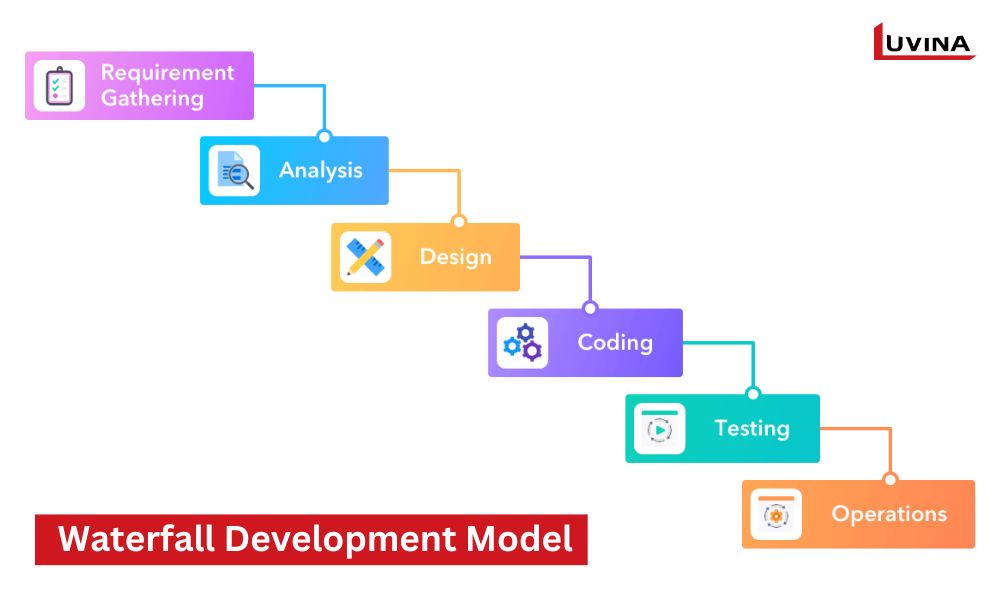A software development methodology is a framework for planning and controlling the workflow during software development. Each approach offers pros and cons tailored to each project’s needs. In this article, let’s delve into the 7 most popular software development methodologies and explore how to choose the most fitting approach for your project.
What is software development methodology?
The software development methodology is a roadmap outlining the software development process, breaking it down into stages. In other words, it provides a specific illustration of the steps to develop software. From the developers’ perspective, the software development models also serve as a form of communication, ensuring that every team member understands the working process.

These methodologies are introduced to benefit both clients and software development companies. Using these methods helps oversee the software development process, enhance project efficiency, and promote logical collaboration within the team.
Top 7 software development methodologies
In general, software development methodologies aid in expressing and organizing various tasks within a software development process more logically and clearly. In this section, let’s delve into the 7 most widely used software development approaches and explore the pros and cons of each approach.
1. Agile development methodology
Agile, as the name implies, is a software development methodology focusing on flexibility. The software development process is split into smaller sprints, each with tasks such as planning, design, testing, change, and maintenance. The development team receives client input constantly to make timely improvements.
This method aims to minimize risks such as errors and exceeding costs during the software development process. However, it is also evaluated as unsuitable for larger organizations.
| Pros | Cons |
| Multiple software versions, with each version being an improvement over the previous one. | Customers hardly keep up with the schedule. |
| Easy testing and maintenance. | Difficulty in estimating resources and costs required for the project. |
| Quick and innovative upgrades and changes. | Lack of strict deadlines. |
| Rapid adaptability, less reliance on initial documentation. | |
| Establishing a close relationship between the software development company and the customers. |
2. Waterfall methodology
This software development methodology is called the Waterfall because the stages in the software development process are executed sequentially: completing one stage marks the beginning of the next; once a stage is completed, it cannot be returned.

This is one of the oldest and classic software development models, suitable for systems that require stability and humble experienced developer teams.
| Pros | Cons |
| Easy to understand, easy to manage | Slow process, and costly. |
| All requirements are clearly defined. | The software only becomes operational after completing all stages of the software development life cycle. |
| Suitable only for projects with clearly defined requirements. | |
| Unable to update or modify once the project reaches the testing stage. |
3. Prototype Model
The Prototype Methodology is one of the software development approaches that allows developers to create a simple prototype of software, enabling customers to understand its functionality. This method is capable of addressing many issues that may arise in the Waterfall model.
| Pros | Cons |
| Allows for early detection and correction of errors. | High resource costs. |
| Can scale according to customer preferences and implement necessary changes. | Too much customer involvement can lead to disagreements. |
| Easy to present to customers. | Limited ability to make significant project changes. |
| Minimizes unnecessary costs after launching. | Customers may lose interest after seeing the prototype or demand the final product immediately. |
| Strengthens the relationship between customers and the software development team. |
4. DevOps development methodology
DevOps goes beyond being merely a software development methodology; it’s also an organizational setup. In adopting this approach, various departments handling distinct phases of the software development life cycle need to work closely together, ensuring the ultimate product’s quality.
| Pros | Cons |
| Shorten time-to-market, and reduce the rate of software errors. | Issues may arise during development if departments don’t collaborate closely enough. |
| Enables continuous innovation to enhance software quality. | Prolonged delivery time. |
| Requires businesses (development teams) to change their working culture, consuming time and manpower. |
5. Rapid Application Development
Rapid Application Development (RAD) is a 4-phase software development methodology that includes planning, user design, development, and delivery. The user design and development phases are iterated until the product meets customer requirements.

This method aims to shorten the software development process while ensuring the quality of the final product. Additionally, it enables developers to iterate and adjust promptly, thereby reducing development costs. This method is suitable for small to medium-sized projects with strict time requirements.
| Pros | Cons |
| Reduces risks for development teams. | Requires highly skilled developers. |
| Allows customers to quickly evaluate the project. | Not suitable for low-budget projects. |
| Minimizes errors during development. | Difficult to monitor progress or detect issues. |
| Easy to modify and improve. |
6. The Spiral Method
Similar to Prototyping, The Spiral is a software development methodology that allows developers to create a prototype to address a specific risk area (usually user requirements or algorithm performance). After evaluating the results, they continue to identify additional risk areas to address. The process of creating prototypes continues until all risk areas are resolved or reduced to the lowest possible level. This method is suitable for large and critical projects.
| Pros | Cons |
| Significantly reduces hidden risks. | High cost. |
| Can incorporate additional functionalities later. | Failure in the risk analysis phase can impact the entire project. |
| Documentation is more extensive. |
7. Lean Development
Lean is a software development methodology that emphasizes minimalism. When applying this method, the software development process is streamlined, eliminating meetings, and documentation,… The goal of this method is to create software with low costs and minimal manpower in a short time.
| Pros | Cons |
| Budget optimization. | Requires accurate judgments for every decision. |
| Accelerates development speed. | Lacks flexibility. |
| Helps developers improve decision-making abilities. | Requires teamwork. |
How to Choose the Correct Software Development Approach
The purpose of software development models is to optimize the process. To choose a suitable model, software development teams can consider the following criteria:
- Project Requirements: Projects with well-defined requirements align with traditional methods like Waterfall; flexible, frequently changing requirements are suitable for the Agile model.
- Project Scale and Complexity: Traditional methods like Waterfall are suitable for small-scale projects; iterative methods with high interaction and feedback, like Agile, are fitting for larger projects.
- Adaptability and Flexibility: If project requirements change frequently, flexible methods like Agile or Spiral are more suitable.
- Time Requirements: Projects with strict time constraints may align with Lean or Waterfall; projects with flexible timelines may be better suited for Agile, Spiral, or Rapid.

- Involvement of Stakeholders: Flexible methods require frequent involvement and interaction among project stakeholders.
- Risk Management Needs: If the client is concerned about minimizing risks during software development, the team should consider methods that require continuous feedback and adjustments, such as Spiral or Agile.
- Skills and Expertise of the Development Team: If the team possesses specific skills aligned with a particular method, using that method will facilitate a smoother development process.
- Specific Needs of Customers in Different Industries: Some customers from specific industries may have needs compatible with a particular method. The development team should consider these needs to choose an appropriate method.
When selecting a suitable software development method, software outsourcing company can combine multiple models as long as they align with the project requirements.
Conclusion
Here is detailed information about the 7 most popular software development methodologies, often chosen by development teams. Each method has its pros and cons. With the detailed descriptions provided, it is hoped that you can easily choose the most suitable method for your project.









Read More From Us?
Sign up for our newsletter
Read More From Us?
Sign up for our newsletter